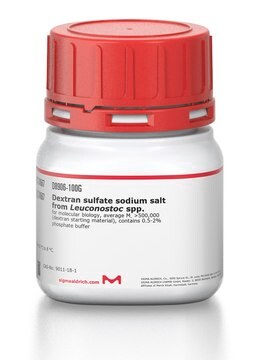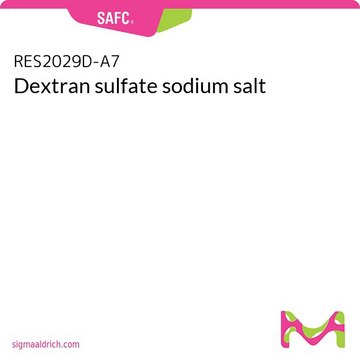67578
Sulfato de dextrano sodium salt
Sinónimos:
Dextran Sulfate Sodium
Iniciar sesiónpara Ver la Fijación de precios por contrato y de la organización
About This Item
UNSPSC Code:
12352201
NACRES:
NA.25
Productos recomendados
form
powder
loss
≤10% loss on drying
useful pH range
6.0-8.0 (10 g/L)
solubility
H2O: 100 mg/mL, clear, colorless to faintly greenish-yellow
storage temp.
room temp
¿Está buscando productos similares? Visita Guía de comparación de productos
General description
Dextran is a polymer of anhydroglucose. It is composed of approximately 95% alpha-D-(166) linkages. The remaining (163) linkages account for the branching of dextran.
Application
Dextran sulfate is routinely used for the selective precipitation of lipoproteins, probe hybridization membrane-immobilized DNA, the release of DNA from DNA-histone complexes, and the inhibition of RNA binding to ribosomes.
Dextran sulfate is used as a diluent in in situ hybridization experiments to increase hybridization of probes to target sequences in tissues.
Other Notes
To gain a comprehensive understanding of our extensive range of Dextrans for your research, we encourage you to visit our Carbohydrates Category page.
Storage Class
11 - Combustible Solids
wgk_germany
WGK 2
flash_point_f
Not applicable
flash_point_c
Not applicable
Elija entre una de las versiones más recientes:
¿Ya tiene este producto?
Encuentre la documentación para los productos que ha comprado recientemente en la Biblioteca de documentos.
Los clientes también vieron
The rate of nucleic acid annealing to cytological preparations is increased in the presence of dextran sulfate.
L L Lederman et al.
Analytical biochemistry, 117(1), 158-163 (1981-10-01)
Rodabe N Amaria et al.
Nature medicine, 24(11), 1649-1654 (2018-10-10)
Preclinical studies suggest that treatment with neoadjuvant immune checkpoint blockade is associated with enhanced survival and antigen-specific T cell responses compared with adjuvant treatment1; however, optimal regimens have not been defined. Here we report results from a randomized phase 2
Nadezhda V Petrova et al.
Cell cycle (Georgetown, Tex.), 15(3), 337-344 (2015-12-23)
Heat stress is one of the best-studied exogenous stress factors; however little is known about its delayed effects. Recently, we have shown that heat stress induces cellular senescence-like G2 arrest exclusively in early S-phase cells. The mechanism of this arrest
Sinah-Sophia Weiterer et al.
The EMBO journal, 39(1), e101533-e101533 (2019-11-09)
How cytokine-driven changes in chromatin topology are converted into gene regulatory circuits during inflammation still remains unclear. Here, we show that interleukin (IL)-1α induces acute and widespread changes in chromatin accessibility via the TAK1 kinase and NF-κB at regions that
Adél Sepsi et al.
Frontiers in plant science, 9, 1193-1193 (2018-08-30)
ImmunoFISH is a method combining immunolabelling (IL) with fluorescent in situ hybridisation (FISH) to simultaneously detect the nuclear distribution of proteins and specific DNA sequences within chromosomes. This approach is particularly important when analysing meiotic cell division where morphogenesis of
Nuestro equipo de científicos tiene experiencia en todas las áreas de investigación: Ciencias de la vida, Ciencia de los materiales, Síntesis química, Cromatografía, Analítica y muchas otras.
Póngase en contacto con el Servicio técnico













